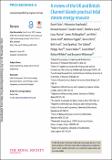A review of the UK and British Channel Islands practical tidal stream energy resource
Abstract
This review provides a critical, multi-faceted assessment of the practical contribution tidal stream energy can make to the UK and British Channel Islands future energy mix. Evidence is presented that broadly supports the latest national-scale practical resource estimate, of 34 TWh/year, equivalent to 11% of the UK’s current annual electricity demand. The size of the practical resource depends in part on the economic competitiveness of projects. In the UK, 124 MW of prospective tidal stream capacity is currently eligible to bid for subsidy support (MeyGen 1C, 80 MW; PTEC, 30 MW; and Morlais, 14 MW). It is estimated that the installation of this 124 MW would serve to drive down the levelized cost of energy (LCoE), through learning, from its current level of around 240 £/MWh to below 150 £/MWh, based on a mid-range technology learning rate of 17%. Doing so would make tidal stream cost competitive with technologies such as combined cycle gas turbines, biomass and anaerobic digestion. Installing this 124 MW by 2031 would put tidal stream on a trajectory to install the estimated 11.5 GW needed to generate 34 TWh/year by 2050. The cyclic, predictable nature of tidal stream power shows potential to provide additional, whole-system cost benefits. These include reductions in balancing expenditure that are not considered in conventional LCoE estimates. The practical resource is also dependent on environmental constraints. To date, no collisions between animals and turbines have been detected, and only small changes in habitat have been measured. The impacts of large arrays on stratification and predator–prey interaction are projected to be an order of magnitude less than those from climate change, highlighting opportunities for risk retirement. Ongoing field measurements will be important as arrays scale up, given the uncertainty in some environmental and ecological impact models. Based on the findings presented in this review, we recommend that an updated national-scale practical resource study is undertaken that implements high-fidelity, site-specific modelling, with improved model validation from the wide range of field measurements that are now available from the major sites. Quantifying the sensitivity of the practical resource to constraints will be important to establish opportunities for constraint retirement. Quantification of whole-system benefits is necessary to fully understand the value of tidal stream in the energy system.
Citation
Coles , D , Angeloudis , A , Greaves , D , Hastie , G D , Lewis , M , Mackie , L , McNaughton , J , Miles , J , Neill , S , Piggott , M , Risch , D , Scott , B , Sparling , C E , Stallard , T , Thies , P , Walker , S , White , D , Wilden , R & Williamson , B 2021 , ' A review of the UK and British Channel Islands practical tidal stream energy resource ' , Proceedings of the Royal Society A - Mathematical, Physical & Engineering Sciences , vol. 477 , no. 2255 , 20210469 . https://doi.org/10.1098/rspa.2021.0469
Publication
Proceedings of the Royal Society A - Mathematical, Physical & Engineering Sciences
Status
Peer reviewed
ISSN
1364-5021Type
Journal article
Description
D.C., J.M., P.T. and S.W. acknowledge the financial support of the Tidal Stream Industry Energiser project (TIGER), which is co-financed by the European Regional Development Fund through the Interreg France (Channel) England Programme. A.A. acknowledges the support of NERC through the Industrial Innovation fellowship grant no. NE/R013209/2. D.G., B.S., T.S., D.W., R.W. and B.W. acknowledge EPSRC for supporting part of this work through EP/S000747/1. G.H. and C.S. acknowledge support by the Scottish government-funded Marine Mammal Scientific Support Programme MMSS/002 with additional resources from the Natural Environment Research Council grant nos. NE/R014639/1 and NE/R015007/1. M.L. acknowledges the support of the Smart Efficient Energy Centre (SEEC) at Bangor University, part-funded by the European Regional Development Fund (ERDF), administered by the Welsh Government, and the EPSRC METRIC fellowship grant no. (EP/R034664/1). L.M. acknowledges the financial support of an EPSRC PhD studentship award, grant no. EP/R513052/1(18-22). J.McN. acknowledges the financial support of R.Willden’s EPSRC Advanced Fellowship grant no. EP/R007322/1. S.N. acknowledges the support of SEEC (Smart Efficient Energy Centre) at Bangor University, part-funded by the European Regional Development Fund (ERDF), administered by the Welsh Government.Collections
Items in the St Andrews Research Repository are protected by copyright, with all rights reserved, unless otherwise indicated.

